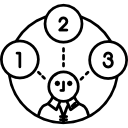Digital signature: Difference between revisions
Mr. MacKenty (talk | contribs) (Created page with "<center> <blockquote style="padding: 5px; background-color: #FFF8DC; border: solid thin gray;"> File:Exclamation.png This is student work which has not yet been approve...") |
Mr. MacKenty (talk | contribs) |
||
| (5 intermediate revisions by the same user not shown) | |||
| Line 1: | Line 1: | ||
[[file:computation.png|right|frame|Computational thinking, problem-solving and programming<ref>http://www.flaticon.com/</ref>]] | |||
</ | |||
</ | |||
A digital signature is a mathematical scheme for verifying the authenticity of digital messages or documents. A valid digital signature, where the prerequisites are satisfied, gives a recipient very strong reason to believe that the message was created by a known sender (authentication), and that the message was not altered in transit (integrity).<ref>https://en.wikipedia.org/wiki/Digital_signature</ref> | |||
The Public and Private key pair comprise of two uniquely related cryptographic keys. | |||
The Public Key is what its name suggests - Public. It is made available to everyone via a publicly accessible repository or directory. On the other hand, the Private Key must remain confidential to its respective owner. | |||
Because the key pair is mathematically related, whatever is encrypted with a Public Key may only be decrypted by its corresponding Private Key and vice versa. | |||
For example, if Bob wants to send sensitive data to Alice, and wants to be sure that only Alice may be able to read it, he will encrypt the data with Alice's Public Key. Only Alice has access to her corresponding Private Key and as a result is the only person with the capability of decrypting the encrypted data back into its original form.<ref>https://www.comodo.com/resources/small-business/digital-certificates2.php</ref> | |||
== | == Encryption == | ||
This is an excellent video which introduces encryption. The part you will really want to pay attention to (related to digital signatures) is at 4:36 into the video. <br /> | |||
<html> | |||
<iframe width="560" height="315" src="https://www.youtube.com/embed/6-JjHa-qLPk" frameborder="0" allow="accelerometer; autoplay; encrypted-media; gyroscope; picture-in-picture" allowfullscreen></iframe> | |||
== | </html> | ||
== References == | == References == | ||
<references /> | |||
[[Category: | [[Category:programming]] | ||
Latest revision as of 14:54, 8 March 2020

A digital signature is a mathematical scheme for verifying the authenticity of digital messages or documents. A valid digital signature, where the prerequisites are satisfied, gives a recipient very strong reason to believe that the message was created by a known sender (authentication), and that the message was not altered in transit (integrity).[2]
The Public and Private key pair comprise of two uniquely related cryptographic keys. The Public Key is what its name suggests - Public. It is made available to everyone via a publicly accessible repository or directory. On the other hand, the Private Key must remain confidential to its respective owner.
Because the key pair is mathematically related, whatever is encrypted with a Public Key may only be decrypted by its corresponding Private Key and vice versa.
For example, if Bob wants to send sensitive data to Alice, and wants to be sure that only Alice may be able to read it, he will encrypt the data with Alice's Public Key. Only Alice has access to her corresponding Private Key and as a result is the only person with the capability of decrypting the encrypted data back into its original form.[3]
Encryption
This is an excellent video which introduces encryption. The part you will really want to pay attention to (related to digital signatures) is at 4:36 into the video.